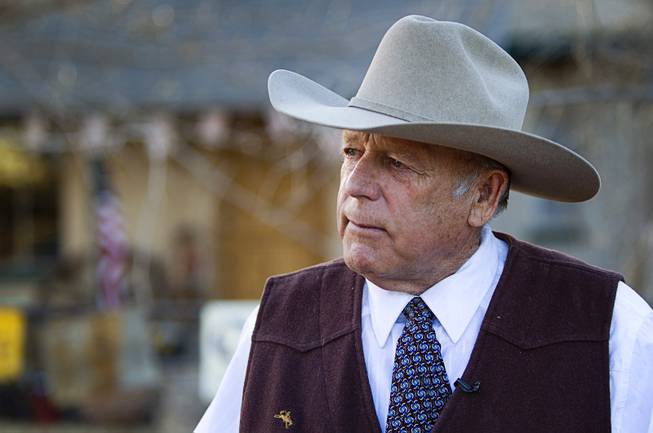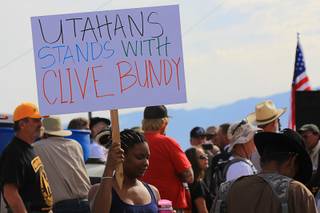
Rancher Cliven Bundy listens to a question from a reporter at his ranch near Bunkerville on Wednesday, Jan. 27, 2016.
Monday, Feb. 6, 2017 | 2 a.m.
When the criminal case against Cliven Bundy, his sons and a group of sympathizers goes to trial in Nevada, their two years of aggressive defiance of the federal government will have finally come home.
The Bundy family’s rejection of the Bureau of Land Management’s control of public lands goes back decades and more than $1 million in unpaid grazing fees, but it was the confrontation at an overpass near their Bunkerville ranch that resulted in the 16-count indictment that soon will be settled in court. It also seeded a movement.
Following a “cattle gather” by the BLM in spring 2014, with federal agents rounding up livestock considered to be allowed to trespass on federal property, the Bundys put out a nationwide call for support in their “range war,” urging lawmakers and sympathizers to make the trek to the tiny town, population 1,300. The family’s position was summed up by Ryan Bundy, speaking before the Bunkerville Town Advisory Board that March:
“If they are going to be out in the hills stealing our property, we will (take) measures of defense,” he said. “And they have always asked us, ‘What will you do, what will you do?’ And our stance has always been, we will do whatever it takes.”
Many of the supporters who descended on Bunkerville were armed militia members from paramilitary groups such as the Praetorian Guard of Arizona, commanded by a “Col. Reaper,” and the Oath Keepers, a far-right outfit that later that year positioned shooters on rooftops during the racial unrest in Ferguson, Mo.
The situation in Bunkerville escalated as the BLM called in armed officers of its own, with both sides preparing for a shootout. Images of militia members aiming AR-15s at officers through slots in concrete road dividers made their way into the international press. Las Vegas Metro’s Joe Lombardo, then assistant sheriff, told KLAS-TV that police were “outgunned, outmanned.”
The actions of then-Sheriff Doug Gillespie, who forbade his officers from wearing riot gear in order to ease the tension, arguably made the difference between a Waco-like incident and a peaceful resolution. His work brokering an agreement between Bundy and the BLM prompted the agency to stand down, effectively ending the standoff.
But the highly publicized conflict launched a public debate about what many feel is a habit of overreach by the federal government. From the get-go, it wasn’t one that a collection of politically incorrect, cowboy-booted ranchers was likely to win. A week after the standoff, Cliven Bundy opined on the lives of African-Americans. Stemming from an instance where he said he saw black families idling outside government housing in North Las Vegas, Bundy implied they would have been better off under slavery. He has said he doesn’t recognize national leadership as “even existing.”
This brand of rural American “straight talk” endeared some to the Bundys’ cause and appalled others. Their prevailing image as gun-toting, Bible-quoting outlaws on the fringe has invited judgment by the mainstream in terms of what UNLV political science professor David Damore called a “welfare cowboy mindset,” demanding special treatment while others pull their own weight.
Still, the majority of Americans think the federal government wields too much power — 6 out of 10, according to 2015 data from Gallup. And right-wing ranchers aren’t the only ones affected.
On Oct. 27, 2016, state troopers and the National Guard advanced on a group of Cheyenne River Sioux protesting the Dakota Access oil pipeline’s route under their reservoir. Police approached the unarmed tribe members with armored personal carriers and assault gear, launching tear gas and concussion grenades in a scene described as “frightening” by journalists on the scene. That same day, Cliven Bundy’s sons Ryan and Ammon were acquitted for their role in an armed takeover of a wildlife refuge in Oregon, a tense occupation over land rights that led to the death of a Bundy supporter who reached for a gun in front of police.
The parallel between Bunkerville and Standing Rock isn’t direct, as tribal ownership of the reservation is recognized by the federal government, whereas the Bundys’ claim on the rangeland is not (the ranch covers 160 acres, while the herd grazes on around 600,000 acres managed by the BLM). But in both cases, local residents took issue with what they viewed as government intrusion on their land, and in both cases, tensions escalated into dangerous confrontations.
However, there was a clear difference in how the groups were treated. Though the Bundy family has complained of mistreatment at the hands of federal agents and the police, they were more or less handled with kid gloves by authorities, who waited out an armed militia’s 41-day occupation of the Malheur National Wildlife Refuge.
The disparity worked against the Bundy cause while emboldening the pipeline protesters and an international outpouring of public support.
“If you’re white, you can occupy federal property ... and get found not guilty. No tear gas, no tanks, no rubber bullets,” Black Lives Matter founder Alicia Garza wrote on Facebook. “If you’re indigenous and fighting to protect our earth, and the water we depend on to survive, you get tear-gassed, media blackouts, tanks and all that.”
Meanwhile, the Bundys and their cohorts were elated by the acquittal, seeming to see it as a validation of their viewpoint and actions. Prosecutors were roundly blamed for the outcome, so their tactics will be under scrutiny in Nevada, where 19 people will face charges including conspiracy, assault and obstruction of justice (the first of three trials begins Feb. 6, though Cliven, Ammon and Ryan Bundy will be part of the second).
The Bundy brothers refused to attend a court hearing in December, echoing the resistance that first sparked the confrontation in Bunkerville. They have held fast to the argument that it’s their duty under the Constitution to abolish any government they find abusive, by any means necessary. And it’s an especially poignant notion in the first weeks of Donald Trump’s presidency, as opposing sides of various conflicts flex and test the boundaries of precedent, whether maneuvering in Congress or marching on city streets.
“We still think it’s illegal to take over a public structure on public land at the end of a gun,” U.S. Attorney Billy J. Williams told the Oregonian after the October verdict. “There’s a distinction between lawful protest and committing criminal acts to prove your point.”
But supporters of the Bundys’ mindset and actions felt validated and emboldened, and that effect could be amplified by if there is a similar outcome in Nevada.


Join the Discussion:
Check this out for a full explanation of our conversion to the LiveFyre commenting system and instructions on how to sign up for an account.
Full comments policy